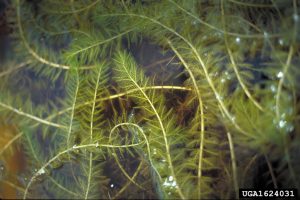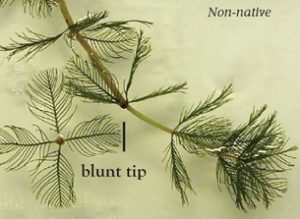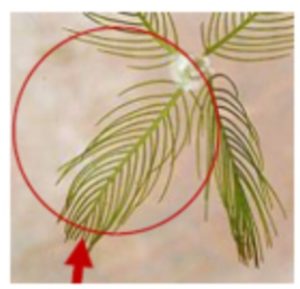
Eurasian Watermilfoil in McGregor Lake
WHAT IS IT?
The Eurasion Watermilfoil is an invasive plant species that has become the number one burden of lakes across Québec and Canada. Nearly uncontrollable, it can attack virtually any lake. This weed infestation lowers property values and undermines enjoyment of the lake. Once introduced in a lake, this plant has the capacity to spread to virtually all areas with depths less than 20 feet. Its mode of propagation is such that the plant spreads at incredible speeds. It has been nicknamed the “zombie plant” due to its ability to multiply even faster once it is cut into pieces. Since the plant can easily reach 3 to 4 meters in length, it can rapidly displace other submerged native aquatic plant species. See below for more details on what to look for to confirm if it’s Eurasian Watermilfoil!
NEW – Resources/articles on Eurasion Watermilfoil:
- https://ici.radio-canada.ca/nouvelle/1898249/etude-presence-myriophylles-lac-des-trente-et-un-milles (published July 14, 2022)
- https://www.cbc.ca/news/canada/ottawa/eurasian-water-milfoil-fish-study-outaouais-1.6521019 (published July 15, 2022)
2020 EURASION WATERMILFOIL STRATEGY & CONSULTATIONS
With the warmer spring temperatures and lower water levels during spring and summer 2020, the growth of Eurasian Watermilfoil in the lake also advanced. Broken pieces were spotted floating on the surface of the lake – pieces that then sprout roots and multiply the problem.
In 2019, the MLA executive and volunteers launched a number of initiatives to raise awareness, educate lake residents and commissioned a research study to give us updated data which will guide the placement of marker buoys. The research was carried out by ABV des 7 and the report was also submitted for inclusion into the VDM Municipality’s Plan Directeur de l’eau (Water Master Plan). All MLA members received access to the report and an executive summary in autumn 2019 (see below).
Adapting the realities of Covid-19, the priorities identified for 2020 are:
- Install a system of markers to signal the presence of Eurasian Milfoil in a few higher-risk areas. White information markers and yellow float balls will be used to identify the beds as areas not to be disturbed.
- Inform and consult with the lake residents in proximity to these areas prior to installation.
- Continue to promote awareness of the problem to MLA members and approach the Municipality to install information signage at the Pélissier Boat Launch.
- Promote use of the pay-per-use boat wash facility which the Municipality is planning to install at the Rt 307/366 junction.
In 2020, the MLA held two (2) information sessions to discuss our three (3) year plan to confront the threat of Eurasian Watermilfoil in our lake. Residents in proximity to the most severely affected areas were invited to join via Zoom. The residents expressed their concerns and shared their ideas on how best to achieve our common goal of keeping McGregor Lake healthy and free of invasive species.
Challenges of critical funding and Covid19 notwithstanding, the MLA has managed to prepare anchors and buoys to be placed in the affected sites, and to move forward with our plan. Looking ahead to 2021, through various fundraising and educational activities, the main focus will be on raising increased awareness of this threat, and building a larger membership base amongst residents and users of the lake to raise much needed revenue to continue our fight against this invasive species.
We are looking for volunteers interested to support Eurasian Watermilfoil activities in 2021. If you can help, please send us an email to: lacmcgregorlake@gmail.com. Social distancing will be strictly maintained for all activities.
Priorities that will be delayed until 2021 include:
- Develop a volunteer Eurasian Milfoil monitoring programme, including training.
- Identify a team of volunteers that can manage the installation and removal of the Eurasian watermilfoil markers each year.
2019 MLA ACTIVITIES TO CURTAIL SPREAD OF MILFOIL IN McGREGOR LAKE
In 2019, the MLA announced a number of activities to alert residents to the severe impacts of the Eurasian Watermilfoil invasive species in an effort to curtail its spread in McGregor Lake.
- Awareness raising was our first priority and efforts included distribution of an info graphic to all members; an information display at the Annual Regatta-BBQ; as well as using the MLA website and Facebook page to provide additional information on this invasive species to MLA members.
- The second priority was to undertake a study and update the 2012 mapping of McGregor Lake (adding the part of Courville Bay east of Nadon bridge) and the 2015 mapping of Mud Bay. The non-profit research group Agence de Bassin Versant des 7 (ABV des 7) was contracted to conduct the study and completed the field research by mid-August. It is now preparing the map and compiling the formal report for the MLA.
- The third activity we announced was the placement of marker buoys to indicate areas of infestation, however, we noted significant changes in some areas identified in the 2012 McGregor map, and decided to prioritize the 2019 research study and await the results before proceeding with installation of the buoys.
2019 Report on Eurasian Watermilfoil at McGregor Lake
The ABV des 7 report commissioned by the MLA in 2019 updated the ABV des 7’s 2012 study of McGregor Lake to get a better picture of the progress of Eurasian Milfoil in the lake generally as well as identify priority areas of concern. We also asked them to provide recommendations for managing this issue. The study was completed in the Fall of 2019. The report is available by clicking this link Mise à jour Myriophylle à épis Rapport final 2019 (available in French only) and a summary report is available in English Highlights Report on Milfoil 2019 and in French Sommaire exécutif – Rapport Myriophylle à épis 2019. Click on this link ABV7 Cartes-Maps Rapport-final-2019 to see a map of areas where Eurasian Watermilfoil has been identified in McGregor Lake.
The board of the Association met at the end of October 2019 to determine next steps:
- Further consultation with both ABV7 and FDVDM to obtain any research and studies about the most significant factors that contribute to the further propagation of Eurasian Milfoil.
- Further research will be undertaken to identify places where Jute application has been installed, to learn about best practices, costs, and potential sources for funding
- Discuss opportunities to develop ongoing monitoring program with FDVDM that could involve training of volunteers and loan of equipment.
- In the Spring of 2020, a system of markers to be installed to signal the presence of Eurasian Milfoil. White markers will be used to identify the beds, and yellow buoys will be used to cordon off the area not to be disturbed.
- Consultations with residents in key affected areas to be undertaken in the early Spring 2020.
- The Association to continue with its education and communications plan and approach the Municipality for support to extend the reach of its materials to all Val-des-Monts residents through signage at the Pélissier Board Launch, and general mailings to taxpayers.
- A three-year budget to be developed for communications and education activities, purchase and installation of markers and buoys, and other remediation efforts.
- Meeting with the Mayor to be organized to review report, anticipated budget requirements with the Municipality to seek additional funding support and press for installation of a boat wash at Pélissier Launch.
A delegation from the Association led by Peter Barton subsequently met with Mayor Laurin on November 22, 2019. The Mayor expressed full support for the Association’s plan and agreed that VDM will provide an information package in the tax bill, put in an article, that we write, in EN VOL and ensure there is signage at the boat launch and around the lake concerning the purpose of the buoys and the Eurasian Milfoil issue. He also confirmed that a boat wash was being finalized for installation. The site will be between the fire hall and city hall at the junction of 307 and 366. The system will be fully automatic and will cost nominally $10 per wash. An inspection sticker will be issued after. In addition, the VDM has, or is going to purchase, a new 115hp zodiac and man it with inspectors.
What to look for to confirm it is Eurasian Watermilfoil

This plant has a well-developed leaf system around the stem and can become extremely dense. Its feather-like green leaves are arranged in whorls around the stem in groups of four or five. The leaves have 12 or more thread-like segments (the native northern milfoil has fewer than 12 threads), and tiny pinkish flowers occur on reddish spikes that stand several inches above the water. The leaves have a blunt tip end (the native northern milfoil has a pointed christmas tree shape). The plant blooms in late July and early August.
This link provides a good description of how to recognize Eurasian Watermilfoil versus other types of weeds.
What are its environmental impacts?
The impacts from Eurasian watermilfoil infestation are numerous and can result in a loss of biodiversity. Eurasion watermilfoil can cause major physical-chemical changes. By growing in densely packed colonies, Eurasian watermilfoil creates a zone of stagnation to such an extent that it stops the natural turbulence of the water. As such, suspended particles present in the lake water get trapped within the milfoil clusters and in turn create new sediments rich in nutrition.
During winter, decomposing plants cause a partial de-oxygenation of the surrounding water which can cause the disappearance of numerous species of fish.
During summer, plants reach again for the surface thereby physically blocking the natural water circulation. As a result, water becomes stagnant leading to high levels of coliforms and other bacteria. During photosynthesis of a large number of aquatic plants, the ph level has a tendency to increase. Lakes can therefore attain ph levels of 10 to 15 during the summer which can in turn negatively affect the entire aquatic ecosystem.
Is there a risk to people?
Eurasian watermilfoil plants can form thick mats that make recreational activities such as swimming, water skiing, boating and fishing difficult or impossible, while providing the perfect habitat for mosquitoes.
Water skiing and swimming need to be avoided in the affected areas to avoid spreading it, as well as due to an increased risk of drowning. Boating is also more difficult in such areas, whether by motorized boats or non-motorized, such as sailboats. Getting watermilfoil entangled in boat propellers can cause damage to your boat and increase boat maintenance and repair costs, as well as result in spreading the weed to other areas of the lake.
What you can do to stop the spread
Eurasian watermilfoil plants can continue to live several days out of the water! Therefore, it is important that once it is safely removed from the lake, it is disposed of in garbage bags.
1. Maintain a natural plant barrier along your shoreline to prevent erosion and don’t dump grass or leaves into the lake. Eurasian Watermilfoil likes to grow in areas where the lake bottom is rich in nutrients.
2. Clean your boat! Since watermilfoil can become entangled in boat propellers, and may wrap around other external parts of your watercraft, you can prevent the spread of it by cleaning your boat before you enter and after you leave any lake or river. If you visit other lakes or rivers, please clean your boat and motor, and empty the water from your hold and livewell before launching it in our lake.
3. Respect the buoys! The buoys will be placed to mark the heavily invested parts of our lake. Please avoid these areas. That means no swimming or boating in the area as your propeller and paddles can cut the weed and then spread it to other areas of the lake.
4. Pick up the pieces! Even a small piece of milfoil can take root. Don’t leave uprooted milfoil on your dock. If you see fragments floating by, pick them up and put them in the garbage.
5. Root out the problem! As some milfoil management methods can do more harm than good, please contact lacmcgregorlake@gmail.com before attempting to remove the weed yourself. Please avoid raking & cutting the weed as it causes fragmentation which is difficult to pick up and is the leading method by which the Eurasian watermilfoil proliferates. This method is also not permitted by Québec’s Ministère de l’Environnement et de la Lutte contre les changements climatiques (MELCC). While several techniques and products have been tried to control watermilfoil, the only two methods currently supported by the MELCC (both still require special permits) are:
- the placement of jute/burlap over the weed, that is weighted with heavy objects (not sand)
- Diver Assisted Suction Harvesting (DASH) method. The Federation of Lakes of Val-des-Monts is exploring the feasibility of using the DASH method. While more expensive, it is the only approved removal method and has had some success in some northern US states like Vermont, and the Province of British Columbia.

